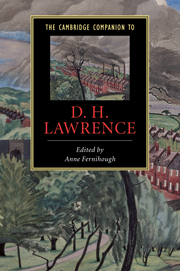Book contents
- Frontmatter
- Introduction
- Part 1 Texts
- Part 2 Contexts and critical issues
- 9 The biographical issue: lives of Lawrence
- 10 Lawrence and modernism
- 11 Lawrence and the politics of sexual politics
- 12 Lawrence and psychoanalysis
- 13 Apocalypse now (and then). Or, D. H. Lawrence and the swan in the electron
- 14 Post-mortem: Lawrence’s critical and cultural legacy
- Guide to further reading
- Index
9 - The biographical issue: lives of Lawrence
from Part 2 - Contexts and critical issues
Published online by Cambridge University Press: 28 May 2006
- Frontmatter
- Introduction
- Part 1 Texts
- Part 2 Contexts and critical issues
- 9 The biographical issue: lives of Lawrence
- 10 Lawrence and modernism
- 11 Lawrence and the politics of sexual politics
- 12 Lawrence and psychoanalysis
- 13 Apocalypse now (and then). Or, D. H. Lawrence and the swan in the electron
- 14 Post-mortem: Lawrence’s critical and cultural legacy
- Guide to further reading
- Index
Summary
Aesthetic autonomy versus biography: the 1930s and after
T. S. Eliot famously argued in 'Tradition and the Individual Talent' (1919) for a perfect division between 'the man who suffers and the mind which creates'. Only thus could artists find the appropriate form for dealing with the problem or issue with which they were tussling; only thus would the necessary impersonality be achieved. In taking a very different path, D. H. Lawrence would pay a price but also find a rewarding freedom. Appreciating the implications of this changes one's understanding of virtually everything he wrote.
Eliot’s desideratum articulated what would become a widely held cultural position. Contemporary reviewers and critics found indifference to Lawrence’s flouting of it impossible. Trenchant, occasionally vitriolic, disagreements resulted; and the dispute gave rise to nearly a dozen biographical studies in the decade after Lawrence’s death in 1930. In addition, many of the reviews of Lawrence’s posthumous publications, and essays and books about his whole oeuvre, took a biographical turn. John Middleton Murry staked out one side of the argument, and Catherine Carswell the other.
- Type
- Chapter
- Information
- The Cambridge Companion to D. H. Lawrence , pp. 157 - 178Publisher: Cambridge University PressPrint publication year: 2001



